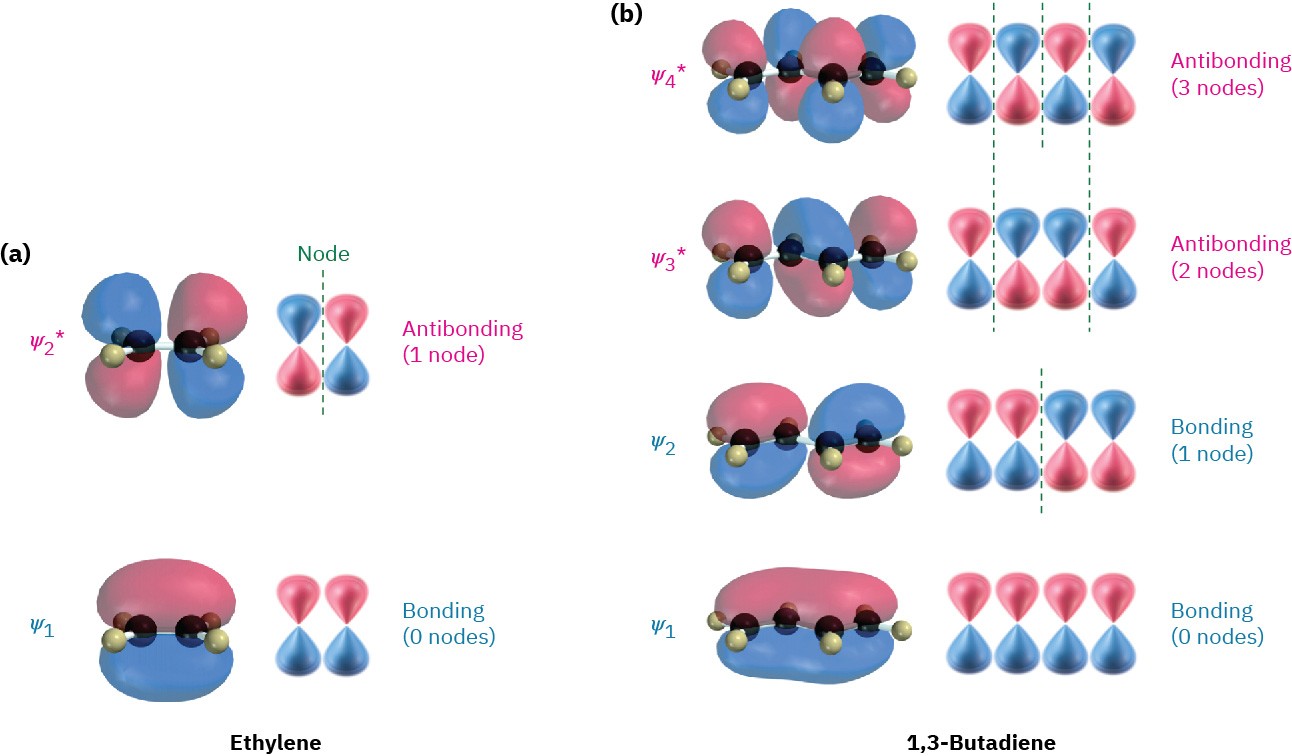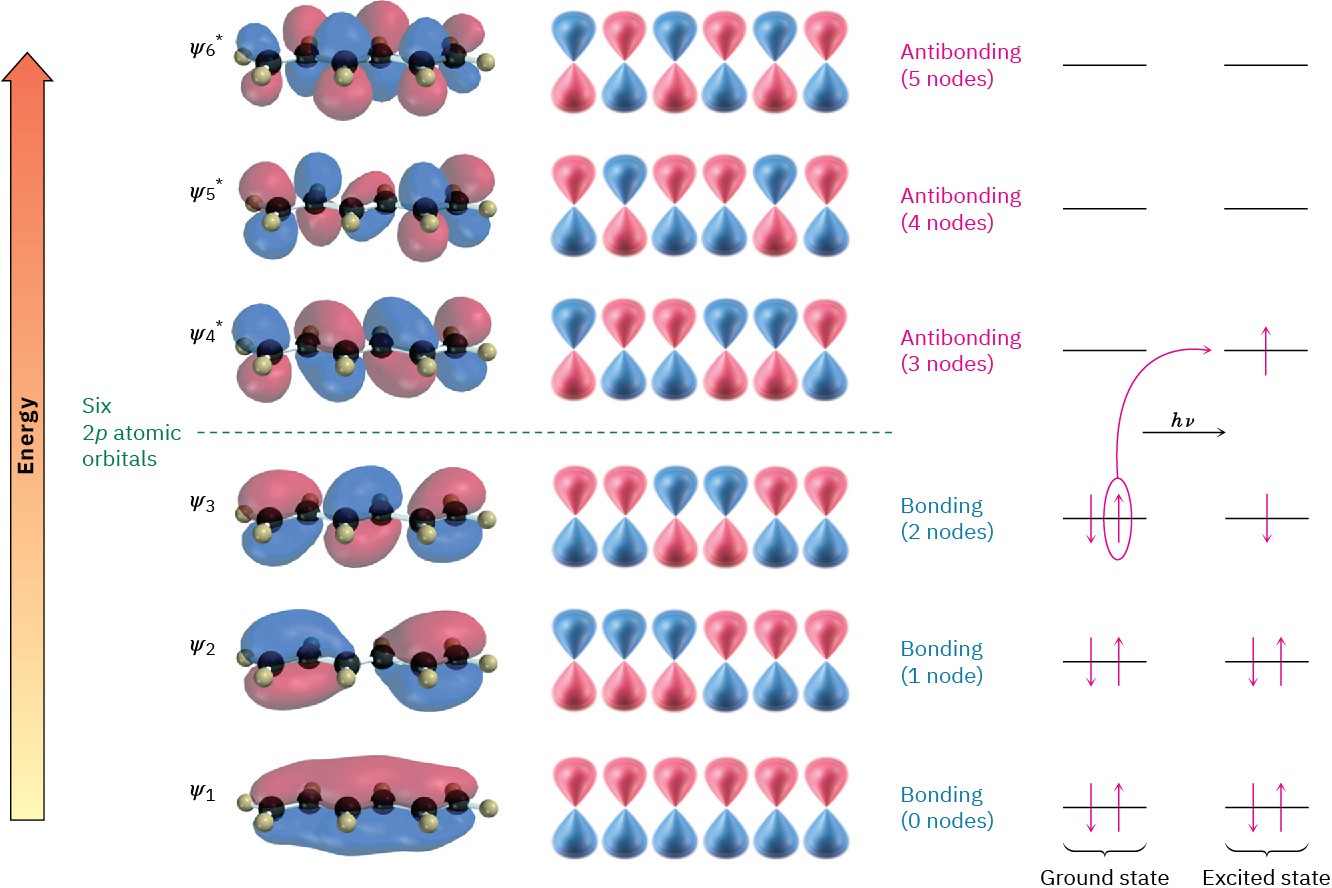30.1 Molecular Orbitals of Conjugated Pi Systems
A conjugated polyene, as we saw in Section 14.1, is one with alternating double and single bonds. According to molecular orbital (MO) theory, the p orbitals on the sp2-hybridized carbons of a conjugated polyene interact to form a set of π molecular orbitals whose energies depend on the number of nodes they have between nuclei. Molecular orbitals with fewer nodes are lower in energy than isolated p atomic orbitals and are bonding MOs; molecular orbitals with more nodes are higher in energy than isolated p orbitals and are antibonding MOs. Pi molecular orbitals of ethylene and 1,3-butadiene are shown in Figure 30.2.

Figure 30.2Pi molecular orbitals of (a) ethylene and (b) 1,3-butadiene.
A similar sort of molecular orbital description can be derived for any conjugated π electron system. 1,3,5-Hexatriene, for example, has three double bonds and six π MOs, as shown in Figure 30.3. In the ground state, only the three bonding orbitals, ψ1, ψ2, and ψ3, are filled.
On irradiation with ultraviolet light, however, an electron is promoted from the highest- energy filled orbital (ψ3) to the lowest-energy unfilled orbital (ψ4*) to give an excited state (Section 14.7), in which ψ3 and ψ4* are each half-filled. (An asterisk denotes an antibonding orbital.)
What do molecular orbitals and their nodes have to do with pericyclic reactions? The answer is, everything. According to a series of rules formulated in the mid-1960s by R. B. Woodward and Roald Hoffmann at Harvard University, a pericyclic reaction can take place
only if the symmetries of the reactant MOs are the same as the symmetries of the product MOs. In other words, the lobes of reactant MOs must be of the correct algebraic sign for bonding to occur in the transition state leading to product.
If the symmetries of reactant and product orbitals match up, or correlate, the reaction is said to be symmetry-allowed. If the symmetries of reactant and product orbitals don’t correlate, the reaction is symmetry-disallowed. Symmetry-allowed reactions often occur under relatively mild conditions, but symmetry-disallowed reactions can’t occur by concerted paths. They either take place by nonconcerted, higher-energy pathways, or they don’t take place at all.

Figure 30.3 The six π molecular orbitals of 1,3,5-hexatriene. In the ground state, the three bonding MOs, ψ1, ψ2, and ψ3, are filled. In the excited state, ψ3 and ψ4* are both half- filled.
The Woodward–Hoffmann rules for pericyclic reactions require an analysis of all reactant and product molecular orbitals, but Kenichi Fukui at Kyoto Imperial University in Japan introduced a simplified version. Hoffman and Fukui shared a Nobel Prize for their work, and Woodward would have joined them (for his second Nobel Prize) had he not passed away before the award was made. According to Fukui’s simplified version, we need to consider only two molecular orbitals, called the frontier orbitals. These frontier orbitals are the highest occupied molecular orbital (HOMO) and the lowest unoccupied molecular
orbital (LUMO). In ground-state 1,3,5-hexatriene, for example, ψ3 is the HOMO and ψ4* is the LUMO (Figure 30.3). In excited-state 1,3,5-hexatriene, however, ψ4* is the HOMO and ψ5* is the LUMO.
Problem 30-1
Look at Figure 30.2, and tell which molecular orbital is the HOMO and which is the LUMO for both ground and excited states of ethylene and 1,3-butadiene.

